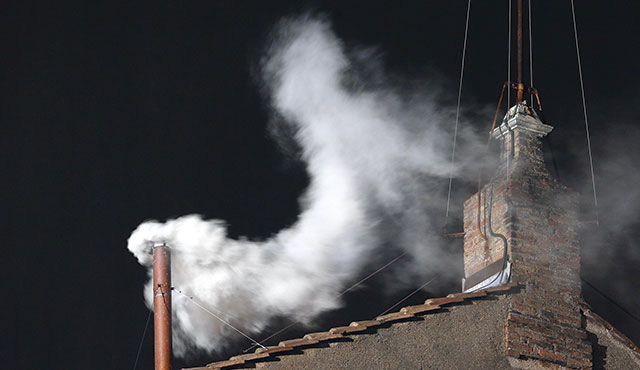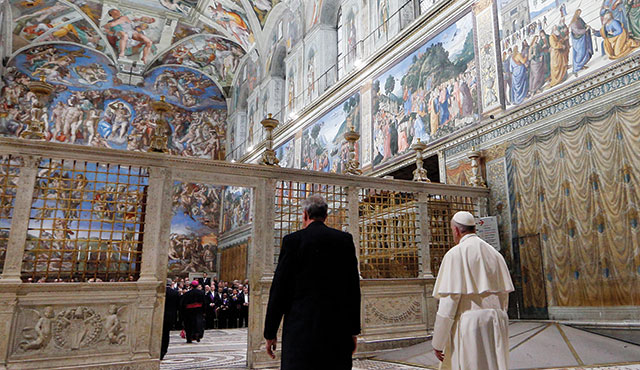“Extra omnes!” So announces the Master of Ceremonies within the Sistine Chapel before the start of conclave, the process that elects a new pope. The Latin command, meaning “Everyone out,” is an order to all but the voting cardinals to exit the Sistine Chapel. The Master of Ceremonies then locks the Sistine Chapel doors, and the voting for a new pope begins.
The current Sistine Chapel, built on the site of the previous Cappella Maggiore, took a little less than 10 years to construct. It was completed in 1481, during the time of Pope Sixtus IV. It was this pope from whom the Sistine Chapel derives its name. Sixtus’ nephew, Pope Julius II, would later commission Michelangelo to undertake the artwork project on the chapel’s ceiling.
Sixtus IV’s successor, Innocent VIII, was elected in the Conclave of 1484. The dean of the College of Cardinals at that time was one Rodrigo de Borgia. Following the eight years of Innocent’s papacy, the Conclave of 1492 became the first conclave held in the Sistine Chapel. Rodrigo de Borgia was elected, and became the infamous Pope Alexander VI.
There is an old saying that the cardinal who goes into a conclave as pope comes out a cardinal. In other words, he who campaigns for pope is bound to lose. It is not a meant to be a role sought by stumping on the campaign trail like a president or senator. In fact, the best possible pope is one who has no investment in the purported trappings of the office. The splendor that has surrounded the papacy is not to glorify the man, but to exalt Christ, of whom the pope is His vicar on Earth.
This has all too often been confused over the course of time, unfortunately. Yet the last six popes, from Pope St. John XXIII through Pope Francis, have sought to respectfully de-mystify the papacy in order for the people of today to better understand its mission. While this attitude has raised concerns in some quarters, Pope Francis, for instance, has brought more attention to the papacy, and thus the Catholic faith, by his humble approach to the office. From carrying his briefcase to riding the bus, these gestures early in his pontificate were clear reminders popes are still priests.
Pope Benedict’s renunciation of the Petrine ministry revealed a humility we are still trying to understand today. Pope St. John Paul II’s tireless voyages around the world brought a personal connection to the Successor of St. Peter. Even in his 33-day pontificate in 1978, Pope John Paul I, with his smile and simplicity, abandoned the sedia gestatoria, the chair that carried the pope around. Pope St. Paul VI donated the papal tiara, and good Pope St. John XXIII discerned it was time for the Church to “open the windows” and assess its relationship with the world by calling the Second Vatican Council.
When a conclave is underway, four balloting sessions are allowed per a day after the first day. An oath is required of each cardinal elector before voting: “I call as my witness Christ the Lord who will be my judge, that my vote is given to the one who before God I think should be elected.” Voting is anonymous, and a ⅔ majority rule is required for a cardinal to be elected pope. After each round, the ballots are burned in the Sistine Chapel chimney. Black smoke indicates no result. White smoke, of course, indicates “habemus papam”––“we have a pope.”
The dean of the College of Cardinals asks, in Latin, to the pope-elect, “Do you accept your canonical election as Supreme Pontiff?” Upon acceptance, the newly elected pope goes into the adjacent “Room of Tears,” and vests in the white cassock of pope. There is no opportunity to put one’s affairs in order. The past life is over. A universal duty is now put before the one elected. He is now in service to God and His people.
What thoughts and prayers are vocalized in silence as cardinals gaze upon Michelangelo’s masterpieces during a conclave? Voting cardinals are barred under the pain of excommunication from revealing what goes on within the Sistine. Yet, Joseph Ratzinger, in conversation with Peter Seewald, revealed what went through his mind as he vested in the Room of Tears before venturing onto the loggia of St. Peter’s as Pope Benedict XVI on April 19, 2005:
“[A]t the moment when it hit me, all I was able to say to the Lord was simply: ‘What are you doing with me? Now the responsibility is yours. You must lead me! I can’t do it. If you wanted me, then you must also help me!’ In this sense, I stood, let us say, in an urgent dialogue relationship with the Lord.”
Editor’s Note: Michelangelo’s Sistine Chapel: The Exhibition, currently on exhibit in the Christ Cathedral Cultural Center, has been extended through August 2020. Tickets are available at sistineexhibit.com


